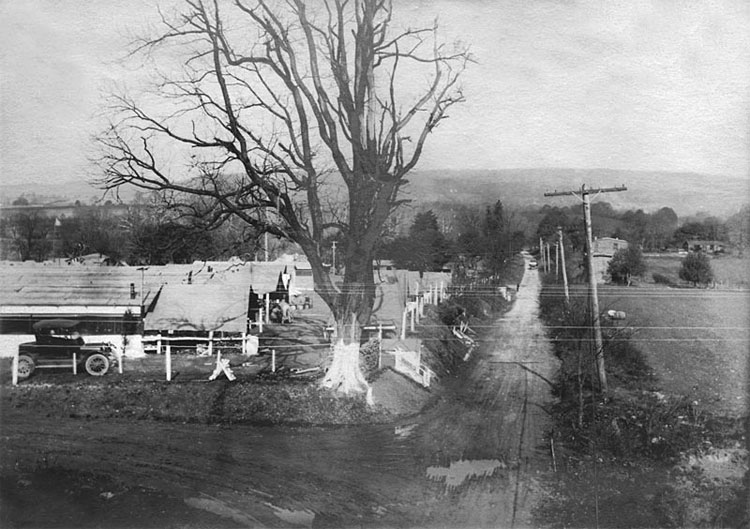
 |
|
Home > Then...Now Index
|
|
Then and Now |
|
|
USMC CAMP FULLER, TREDYFFRIN TOWNSHIP |
|

Photographed in 1918 |
|

Photographed by Joyce A. Post, February 2005 |
|
|
With the U. S. declaration of war against Germany in April, 1917, a massive military buildup occurred throughout the country. The Great Valley was no exception to this contribution. In May, 1918, between 500 and 700 U.S. Marines were transferred to the newly established Camp Fuller, a Marine training camp in Tredyffrin Township on the west side of Cedar Hollow Road running immediately north from the PRR's Trenton Cut-Off toward the tracks of the Chester Valley Branch of the Reading Railroad. The headquarters of Taylor Gifts, and portions of the Vanguard campus, now occupies the site. At the start of World War I, the Marine Corps had only a single company of trained signal personnel — some 60 men — scattered throughout the entire Atlantic fleet. Battlefield communication had become critical on the Western Front, and increased numbers of trained personnel were essential for the war effort. Some signal instruction had already taken place at Valley Forge, and the 37-acre Tredyffrin property of Dr. A. A. O'Daniels was chosen for the new camp. Camp Fuller was largely a tent city, with canvas squad tents laid out on either side of dirt streets. Additionally, there were three frame mess halls, lavatories, a large showering facility, and a sick bay. All tents and buildings had pine wood floors or decks. While there was some generated electricity, light was mostly supplied by candle and lantern. New recruits and replacements arriving at Philadelphia's Broad Street Station were marched the 20 miles out to Camp Fuller, with a lunch stop at Villanova College. Their excess baggage, along with supplies and rations, came to the camp in daily trips by trucks from the Philadelphia Navy Yard. The installation itself was assigned several trucks, three motorcycles, and a few cars privately owned by officers. Everything else moved by foot. Instruction was given in the combat use of Morse code, night lamps, radio, telephone, and even semaphore, and in laying wire on a battlefield and erecting poles. A grid of deep trenches was dug to replicate the combat conditions in France and Belgium, and long after the camp closed, local residents would recall, as children, playing soldiers in these weed-covered trenches. The mess sergeants took advantage of produce and supplies from local farms and dairies, and the food was considered to be well above average by the troops. Marines would come up to Paoli for diversion provided by the Paoli Red Cross, and many were entertained by local residents. One home was set up as a center with a card room, books, music, pool tables, a canteen, and sleeping quarters and shower baths with unlimited hot water. In addition, the local YMCA sponsored a tent at the camp for writing, motion pictures, lectures, and public speakers. The troops were preparing to ship out to a new camp in France when the Armistice was announced on November 11, 1918. The movement never occurred, and Camp Fuller was disbanded immediately afterwards. At least 4 of the Marines stationed at Camp Fuller chose to remain in the area, settling in Berwyn, Paoli, and Malvern.
|
|
|
Page last updated: 2007-03-21 at 16:25 EDT |